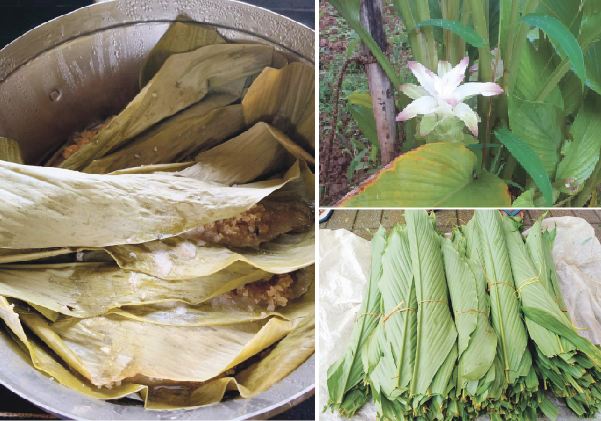Goa is abuzz with excitement as vintage bike and car owners, users, collectors and fans are decking […]

IT’S SHRAVAN-KA-MAHINA NOSTALGIA FOOD!
Aug 14- Aug 20, 2021, Life & Living August 13, 2021It’s patoli season in Goa: turmeric leaf steamed sweet! Here you see (clockwise from top-left) turmeric plant flower, bundle of turmeric leaves in the market and the finale, delicious pattoleo! (Pic contribution by Pramila Prabhu Chodnekar of Old Goa)
By Tara Narayan
WE’RE in Shravan-ka-mahina mode and I’m thinking of where I can the best patoli or patolyo or pattoleo in town Panaji! These days in the Panaji market I see a lot of these bundles of lush green turmeric leaves and these are used to make the season’s sweets and one of them, the most familiar to be seen come Goa’s Independence Day or Liberation Day – pattoleo.
I asked a Catholic friend of mine what’s the difference between the Hindu patoli and Christian pattoleo and she laughed, “For God’s sake what’s religious about sweets, both of us make pattoleo in the same way – what you need is fine rice flour, palm jaggery, freshly grated coconut, flavoring of choice. My mother used to make pattoleo with a sweet chana dal stuffing which made for a richer tasting pattoleo…but pattoleo is traditionally the sweetest and humblest of sweets and even the poorer homes would make them come the Feast of Assumption on August 15. It’s a kind of unity in diversity sweet if you like this interpretation.” I like! I love this simplest of Goan sweets steamed in the turmeric leaves of the monsoon season and look for them every time come Goa’s independence day.
Patoli or however you pronounce them are steamed turmeric leaf bundles which unwrap to reveal these translucent white rice crescents with a stuffing of dark palm jaggery and coconut choon (grated coconut). Patoli are integral to Goa, a sweet to beat all sweets in simplicity and “yummyliciousness” but hey you’ve got to make them with your heart in them. That is properly. A cold, soggy and made far much in advance patoli can be most off putting, they spoil easily.
Most everyone from children to adults to seniors love freshly made patoli and you will find them in most homes come Indian Independence Day on August 15 and Goa’s Liberation Day on August 19. Look for a these lovely steamed green leafy parcels which are actually distributed all around at functions celebrating both India’s and Goa’s special days. Both Hindu and Christian homes make these patoli or patoleo. Remember for the Hindu community it’s Nag Panchami Day too and may be Lord Shiva’s pet nag loves patoli!
Unfold the warm soft leafy turmeric leaf delicately and take time to savor the dark mass of deliciousness encased in the white crescents. It’s an ethnic treat like no other. All you need to make patoleo is rice flour, grated coconut, grated palm jaggery, cardamom or nutmeg and the leaves of the turmeric plant heady with aroma….some do make patoleo in banana leaf parcels too but no comparison please, the alchemy of turmeric leaf patoleo wins hands down.
I know patoleo are easy to make at home but I’ve taken to buying them every year if I find some tempting looking ones in any of the women’s co-operative stores. Then with the commencement of the Hindu calendar’s Shravan-ka-mahina there’re also all the other niche recipes served up on a splendid designer thali (platter) or banana leaf ….think mouth-watering stuff like biya tonak or Goan caju masala curry, gotache sasav (wild mango curry, the lip-smacking tangy sasav could be of ananas (pineapple) or even better the wild ambade (hogplums); there’re two varieties of ambade, the oval greens with a small stone in them and the larger tennis ball sized greens which have a sweetish tartness if you know what I mean, I mean these variety are not so sour that they may leave the teeth which bite into them on edge!
Other highlights of Shravan-mahina are the light-hearted dalicho ros (a tur dal flavored with drumsticks) to go with the steamed rice, phulka or puri; since stuffed ridge gourds are plentiful during monsoon days you may find bharilli ghosali or stuffed ridge gourd. There’ll be the crusty kappam or rava fries of breadfruit, potato, aubergine…and alsanache tonak, also karela (bitter gourd) karam or relish and to wind up a creamy rice kheer made with a small bundle of turmeric leaf swirling in it for that lovely wee turmeric flavor infusion in it. Forget kheer, I always wish for a pataleo this one time in the year in Goa.
THE Shravan food won’t feature onions and garlic, okay, they’re considered rajasik or tamasik by Hindu religious opinion and a no no for any Shravan mahina fasting and eating the one meal a day lunch time or brunch time or early dinner before the sun sets. The last time I had a scrumptious and memorable Shravan mahina thali meal was at the Taj-Vivanta at its Goan Stories restaurant, it was curated by Shubra Shankwalkar. She had on her menu such things as hogplum karam, vodyachi kismoor, and of course my favorite moogache gathi.
My two all-time Saraswat Brahmin or GSB classical favorites are always moogache gathi and khatkhate (medley of monsoon season local veggies flavorful and aromatic with the tirphal berry, a citrusy berry). Another favorite is the vataneche tonak (white peas are used, protein rich and delicious, tonak makes for a lighter flavorful gravy). There’s also the mush loved olmi or wild mushroom shagoti or xacuti, but these prized misty mushrooms are selling in the sly monsoon market at Rs700 to Rs1,000 per pile and nobody dares to used them too generously in xacuti for any bulk cooking. Don’t adulterate with cultivated button mushrooms please!
By the way, tonak is a lighter coconut curry, and I far prefer it to the richer sweetish curries of uddamethi. If you’re lucky the piece de resistance something sweet to wind up the Shravan meal will be rice kheer cooked with a piece of turmeric leaf in it….it makes all the difference for a connoisseur’s high! I think one should make the kheer out of the more flavorful red rice though and not be so silly about only white polished rice. Use one of the local rice but not ambemor rice which has its own “mango” aroma and will clash with spice leaf turmeric aroma. It’s best to make plain ambemor kheer and sweeten with palm jaggery naturally. Sona masuri rice too is okay.
Well, cheers to all the Shravan mahina fasting and feasting… and I’m supposed to be worried about losing weight!
A recipe for pattoleo (adapted from a recipe by Sindhu Navelkar in ‘Food Stop.’ This is an early and pioneering cookbook of Goan recipes and other useful information.)
Pattoleo
(Sweet coconut mix wrapped in turmeric leaves and steamed.)
Ingredients: Half kg semolina or fine rava (cream of wheat), salt to taste, turmeric leaves , 1 fresh grated coconut, half cup jaggery, cardamom powder.
Method: Soak the semolina in water enough to make it into a wet paste. Keep aside. To the grated coconut, add the jaggery and cardamom powder. Mix well. Take a turmeric leaf, spread out the rava paste and spread a spoonful of the coconut filling in the center. Turn over the flap and press to seal the edges. Repeat procedure for other patoleo. Pressure cook for about 10015 minutes.
Variation: The outer cover is generally made of rice, soaked and ground to a coarse paste. However, using semolina, the process is faster.
PS: For adventure try making a patoleo using red rice batter. Also, nutmeg is the other flavor many like in lieu of cardamom but I think both flavors clash with the aroma of turmeric leaf infused in the sweet during the steaming. Turmeric leaves are available in bundles for Rs20 in the market currently, depending on the number of leaves.















